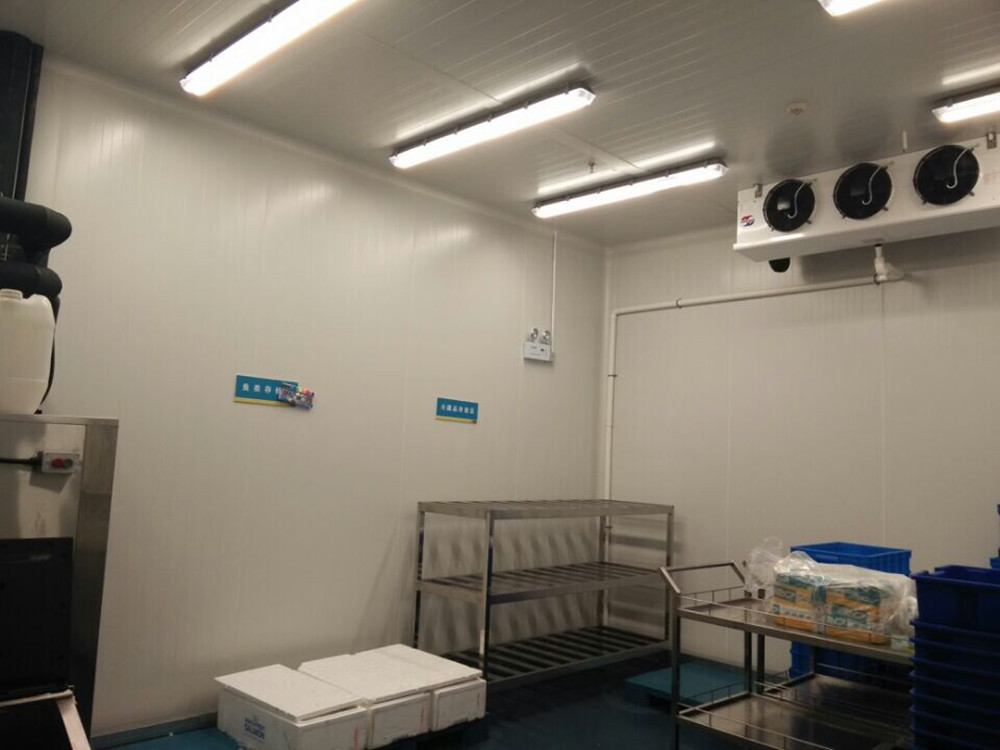Cold room Storage capacity calculation of cold storage Calculate the tonnage of the cold storage: (calculated according to the design specifications of the cold storage and the relevant national standards for the storage capacity of the cold storage):
The internal volume of the refrigerated room × the volume utilization factor × the unit weight of the food = the tonnage of the cold storage.

The first step is to calculate the actual space available and stored in the cold room:
Internal space of the cold room - the aisle space that needs to be set aside in the warehouse, the position occupied by the internal equipment, and the space that needs to be reserved for internal air circulation, use coefficients to estimate or calculate);

The second step is to find out the weight of the items that can be stored per cubic meter of space according to the category of the inventory items, and multiply this to get how many tons of products can be stored in the cold storage;
500~1000 cubic = 0.40;
1001~2000 cubic = 0.50;
2001~10000 cubic = 0.55;
10001~15000 cubic = 0.60.
Note: According to our experience, the actual available volume is greater than the volume utilization factor defined by the national standard. For example, the national standard 1000 cubic meters of cold storage utilization factor is 0.4. If it is placed scientifically and effectively, the actual utilization factor can generally reach 0.5. -0.6.
The unit weight of food in the active cold storage:
Frozen meat: 0.40 tons can be stored per cubic meter;
Frozen fish: 0.47 tons per cubic meter;
Fresh fruits and vegetables: 0.23 tons can be stored per cubic meter;
Machine-made ice: 0.75 tons per cubic meter;
Frozen sheep cavity: 0.25 tons can be stored per cubic meter;
Deboned meat: 0.60 tons per cubic meter;
Boxed frozen poultry: 0.55 tons per cubic meter.

Maintenance of cold storage
1. After the cold storage and refrigeration equipment are newly installed or out of use for a long time, they should be fully tested and debugged when they are used again. When all the indicators are normal, they can be put into use under the guidance of professional refrigeration technicians.
2. Pay attention to the collision and scratching of the cold storage body and the outer body by hard objects during use. Because it can cause dents and rust, it will seriously reduce the local thermal insulation performance.
3. Since the prefabricated cold storage is made up of several insulation boards, there are certain gaps between the boards. These gaps will be sealed with sealant during construction to prevent air and moisture from entering. Therefore, some parts of the seal failure should be repaired in time in use. We must resolutely put an end to the phenomenon of escaping cold.
4. Generally, small prefabricated cold storage uses thermal insulation boards. When using the cold storage, a large amount of ice and water should be prevented on the ground. If there is ice, it must not be hit with hard objects when cleaning to damage the ground.
5. Initial operation of the unit: Always observe the oil level and oil return of the compressor and the cleanliness of the oil, and find that the oil is dirty or oily
The drop should be solved in time to avoid poor lubrication.
6. Always clean the air cooler to keep it in good heat exchange state. Check whether the motor and fan rotate flexibly. If there is blockage, add lubricating oil; if there is abnormal friction sound, replace the bearing of the same type and specification to clean the dirt on the fan blade, coil and water pan. For the chiller unit, the condenser should be checked frequently. If there is a scaling problem, the scale should be removed in time.
7. For the evaporator: it is necessary to check the defrosting situation frequently. Whether the defrosting is timely and effective will affect the refrigeration effect and cause the refrigeration system to return to liquid.
8. Always observe the running status of the compressor; check its exhaust temperature, and pay special attention to the running status of the system when running in a seasonal change, and adjust the liquid supply volume and condensing temperature of the system in time.
9. Listen carefully to the running sound of the compressor and the condenser fan, and deal with the abnormality in time. At the same time, check the vibration of the compressor, the exhaust pipe and the ground. Check the compressor for unusual smells
10. The internal cleanliness of the initial system is poor, and the refrigeration oil should be replaced after 30 days of operation. For systems with higher cleanliness, it should be completely replaced after half a year of operation (depending on the actual situation).

11. Refrigeration technicians inspect and maintain the compressor once a year. Check compressor oil level and oil color. If the oil level is lower than the 1/2 position of the sight glass, the cause of the oil leakage should be found out and the fault should be removed before filling with lubricating oil; if the oil has changed color, the lubricating oil should be completely replaced. Check for the presence of air in the refrigeration system and vent it if present.
12. Always check and confirm whether the voltage of the power supply meets the requirements. The voltage should be 380V±10% (three-phase four-wire). When the cold storage equipment is not used for a long time, the total power supply of the fresh-keeping cold storage should be cut off, and the cold storage equipment should be protected from moisture and other substances such as dust.
13. Regularly check whether the connecting pipes of the refrigeration unit and the connecting pipes on the valve parts are firm, and whether there is refrigerant leakage (generally, there will be oil stains in the places of leakage).

